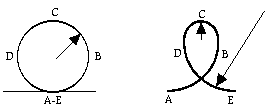

The designers of the Klothoid loop have invented a shape that controls the forces you experience as you go around the loop. The unique shape of the loop decreases the forces exerted on you as you enter and leave the loop, but maintains the force necessary to keep you in your seat as you go over the top of the loop. Thus, the shape of the loop controls the forces you experience.The two loops drawn above have the same height so a coaster at point A, point B, point C, etc. in each loop would have the same speed due to energy considerations. But, at points A and E, where the coaster has the most speed, the Klothoid loop is curved more gently (larger radius) than the circular loop. Consequently the centripetal force you experience (F=mv2/r) is less in the Klothoid loop than in the circular loop. At point B, where the coaster is moving the slowest, the Klothoid loop is more tightly curved than the circular loop. Thus as you cross the top of the Klothoid loop a force from the seat fighting your inertia squeezes you in, keeping you from falling out.
Several of the roller coasters at California's Great America have vertical loops. Use your vertical accelerometer to obtain vertical acceleration readings at each of the five places identified above for the vertical loop on one of the rides. At the same time, use the horizontal accelerometer to measure the longitudinal acceleration in those same places. Record your values in the data table, and answer the questions that follow.
Your Ride: ______________________________________
|
|
Acceleration |
Acceleration |
Speed * |
Energy * |
Energy * |
|
|
|
|
|
|
|
|
|
|
|
|
|
|
|
|
|
|
|
|
|
|
|
|
|
|
|
|
|
|
|
|
|
|
|
|
|
|
|
|
|
|
* Use these descriptors: smallest, small, medium, large, largest -- with -- increasing, decreasing, steady
NOTE: The vertical accelerometer measures relatively how much force the seat pushes up on you. If it measures 2 g's, the seat will be pushing up on you with twice your normal weight. In return, you feel twice as heavy. The longitudinal accelerometer measures how much force you are pulled forward or backwards with, partly due to gravity and partly due to the seat back or the restraint system.Complete the table below:
|
Description |
Location |
Why description applies there |
|
Place you experienced the greatest vertical acceleration (vertical force) |
|
|
|
Place you experienced the least vertical acceleration (vertical force) |
|
|
|
Place you experienced the least longitudinal acceleration (longitudinal force) |
|
|
|
Place you were pulled or pushed forward by gravity or the ride |
|
|
|
Place you were pulled or pushed backward by gravity or the ride |
|
|
At points B and D, where you were going vertically upward or downward, you still had a vertical force pushing "up" on your seat. Why was there such a force at these two points?
If you are feeling a vertical acceleration (vertical force) at point C, it is directed downwards! Why don't you fall out if the force from your seat is pushing you down?
Click here to download an MS Word file for this activity - klothoidloop.doc.
Click here to download a pdf version of this activity - klothoidloop.pdf
Updated January 2012